Louisiana’s Wheat Crop Headed Toward Disaster For 2015
BATON ROUGE, LA.
Excessive rain across Louisiana is compounding already existing problems with the 2015 wheat crop and leading to what LSU AgCenter experts call a disastrous season.
Wheat is normally harvested from mid-May to the first week of June in south Louisiana and from the end of May to mid to late June in north Louisiana, according to Steve Harrison, LSU AgCenter wheat breeder. But rain is keeping farmers out of muddy fields and contributing to quality deterioration in the wheat crop.
Some of the wheat being harvested has low test weight and, thus, reduced value.
“A normal test weight is 60 pounds per bushel,” said Josh Lofton, LSU AgCenter extension wheat specialist. “But down south we’re seeing wheat in the high 40s and low 50s.”
Grain elevators are either rejecting the low-quality wheat or significantly docking the price, he said.
Some of the wheat will be left in the field because it’s not worth harvesting.
“They’ll plow it under and plant soybeans,” Harrison said, adding that some farmers will let the damaged fields go fallow for a year.
About 85 percent of Louisiana’s wheat producers use a double-crop system in which they harvest wheat in the spring and then immediately plant soybeans. After they harvest the soybeans, they then plant wheat again, which grows over the winter season.
“The 2014-2015 wheat growing season has been challenging, to say the least,” Lofton said.
It started with sub-optimum planting conditions through late fall, Lofton said. Then there were freezes in March when the wheat was growing rapidly. The low temperatures didn’t kill the crop but caused damage that weakened the stems and resulted in the crop collapsing after heading.
“We had horrible conditions during dry down and seed fill,” Lofton said.
Then bad storms hit with heavy rain, high winds and even hail in some areas.
These conditions can cause wheat to fall over, or lodge, which then makes harvest difficult because the harvesters can’t pick up the crop as easily. Harvesting becomes less efficient and more costly.
“I’ve seen excessive lodging,” Lofton said of this year’s crop, adding that the lodged wheat appears either matted down or snapped near the stem base.
“The fields look like they’ve already been harvested,” he said.
The continual wet conditions are favorable for development of a disease on wheat called Fusarium head blight, commonly known as scab, which can lead to low yields, low test weight, dockage and even rejection at the elevator.
“This is the worst year by far for scab,” said Boyd Padgett, LSU AgCenter plant pathologist and director of the Central Region, who’s been studying diseases in wheat for more than 20 years.
“It’s 10 times worse than I’ve ever seen,” Harrison said.
Even though many growers noticed scab appearing in their fields, there was little they could do. The crop was infected at flowering, which is in April, at the same time as heavy rains. Applying fungicides would not have been effective, Lofton said.
Last year’s big corn crop contributed to scab development because corn serves as a host for the fungus that causes the disease, Harrison said.
Because of all the problems, Harrison expects yield losses of 30 percent to 40 percent for the 2015 wheat crop.
LSU AgCenter economist Kurt Guidry said these projected yield losses could translate into about a $13 million economic loss, based on the 130,000 acres planted to wheat.
“This is a very preliminary number,” Guidry said, adding that he is currently conducting a survey to refine this estimate as well as to identify other economic factors over and above yield loss.
“The estimate only considers yield loss and does not address the quality issues that could result in lower cash prices to producers as well as increased production costs,” he said.
Because of this year’s severe scab problem, Harrison expects that less wheat will be planted next year. However, he and other wheat breeders are developing Fusarium-resistant varieties.
“We’re about to release one with good resistance,” Harrison said. “It should be available to farmers in a couple of years.”
Wheat is grown all over the state but mostly in a vertical belt extending from Tensas Parish in the northeast to Pointe Coupee Parish in the south, with about 90 percent in the central and northeast regions. ∆
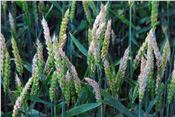
A close view of wheat with scab disease. Note the salmon-colored fungal growth.
Photo by Steve Harrison
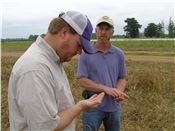
Josh Lofton, left, LSU AgCenter extension wheat specialist, and Trey Price, LSU AgCenter plant pathologist, check a field in which the wheat has lodged, or fallen over, because of heavy rains and high winds.
Photo by Craig Gautreaux
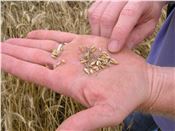
Trey Price, LSU AgCenter plant pathologist, holds kernels of damaged wheat. Scab turned some of the kernels a pinkish color. Others are weathered because of poor harvest conditions.
Photo by Craig Gautreaux
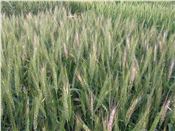
A wheat field heavily infested with Fusarium head blight, commonly known as scab.
Photo by Boyd Padgett
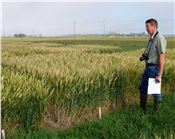
Don Groth, plant pathologist at the LSU AgCenter Rice Research Station, is next to a Fusarium screening plot at the station, which is part of a statewide project to develop wheat varieties resistant to Fusarium head blight, a disease commonly known as scab.
Photo by Steve Harrison